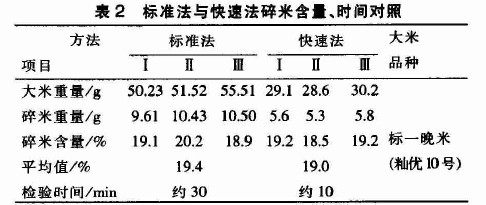The current national standard “Test method for broken rice using grain and oil materials†is expensive, time-consuming, and slow. It does not apply to the inspection and control of broken rice content in the rice production process. The rapid test of broken rice content can effectively solve these problems.
1 Experimental principle
According to the requirement that the broken rice content error in rice production process is less than 2% of soil and the crushed amount in rice is about 20%, use a tray balance with an inductance of 0.1g to determine the weight Wg of the rice sample. According to the formula 0.1/Wx20 %=2%, the weight of the rice sample is 25 g. Approximately 25 g of rice is divided equally by a sampler, and an aluminum sieve having a pore size of 0.5-1.0 mm larger than the width of the entire rice is selected, and the whole rice and broken rice are separated according to a certain sieve width, sieve speed, and rotation speed. According to regulations, the whole rice in the broken rice is picked out, and the broken rice in the whole rice is weighed together with the broken rice weight Wg. According to the formula W, /W, the percentage of the broken rice content is calculated.
2 Inspection instruments and materials
Sample dividers, tray balances (fluence 0.1 g, 0.01 g), grain aluminum sieve (aperture 2.5 mm, 3.0 mm, bottom, cover), sample tray, standard rice (Kamyo 402), standard one night rice (glaze You No. 10)
3 experimental methods
3.1 National Standards Act
From rice samples that have been inspected for impurities, divide approximately 50g of rice by a sampler evenly, and pour it on a glass plate, pick out the broken rice with a length of less than 2/3 of the whole grain of rice, and weigh with the balance of 0.01g. Break the weight of rice, calculate the broken rice content, and record the time for each test.
3.2 Quick test
From rice samples that have been tested for impurities, about 25 g of rice is divided evenly by a sampler, and it is poured into a suitable diameter of the sieve layer. At a rate of 1 turn per second, the radius of gyration is about 10 cm. When the sieve is rotated 10 o'clock in a clockwise direction, the sieve is taken out, the rice on the sieve is carefully poured on one end of the glass plate, the sieved material is poured into the sample tray, the sieve layer is re-jammed, and the sieved material is poured into the sieve. The method was further screened twice. In the second round, the sieves were rotated 8 times in the positive and negative directions, and the third sieve was 4 times. The oversize and undersize were poured onto the glass plate. According to the regulations, the whole rice in the broken rice and the broken rice in the whole rice are picked out, the weight of the broken rice is weighed with a balance of 0.1 g, the broken rice content is calculated, and the time for each inspection is recorded. See the test results in Table 1, Table 2


50 g of rice was taken from the rice sample for inspection and tested by the rapid test method. The specific operation was the same as the 25 g method. The test results are compared with the national standard law in Table 3

4 Results and Discussion
From Tables 1 and 2, we can see that the broken rice content test and the rapid method are compared with the standard method, resulting in an error of +0.6% in the early morning rice and 0.4% in the standard night rice, which is less than 2% of the soil, and the test time is shortened by 20 minutes. . The rapid method of rice broken rice content has the advantages of small error, high speed, and short time. It can be applied to the inspection and control of broken rice content in rice production and sales.
Your Power, We Can! , https://www.aerobspower.com